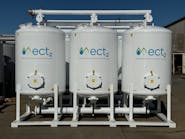We did it — we made it to the end of 2021! Though we got off to a rocky start, we ended with a bang as some much-needed relief for the water sector came via a series of major funding allocations from the White House and The House of Representatives in November.
The $1 trillion Infrastructure Investment and Jobs Act, signed by President Biden in November, will provide $55 billion for drinking water, wastewater, and stormwater infrastructure. New funding streams for the WIFIA program, State Revolving Funds, small and disadvantaged utilities/communities, and the lead service line replacement program were included as part of the package. Just one week later, the Build Back Better Act, which could provide $1.75 trillion for further infrastructure support passed the House of Representatives. While that bill will likely face opposition and heavy revision in the Senate, the renewed focus on water infrastructure is a nice change of pace and indicates a national focus on long-deferred needs in the sector.
“What remains to be seen is how much of this funding will filter into the digital water space and how much will reach the market’s traditional network and treatment infrastructure,” Bluefield Research’s Reese Tisdale writes in A Whole New Ball Game, on page 8.
“As we enter a new year, shifting market forces will continue to reshape strategies for companies across the water value chain, from technology vendors to utility and corporate stakeholders,” he continues. “In many respects, the cause for change has been underway for decades, but the unexpected has compounded the list of challenges.”
Indeed, the ongoing effects of the pandemic, coupled with workforce shortages, aging infrastructure challenges, security, and supply-chain disruptions will continue to affect the industry. Forward-thinking utilities will want to get ahead of these challenges. With the new year upon us, it’s time to step up to the plate.
New Buy America requirements under the infrastructure bill may fundamentally change the way manufacturers get the job done, as new domestic content requirements will apply to every loan and grant program administered by EPA, USDA, the Bureau of Reclamation, U.S. Army Corps of Engineers, and across the entire federal government.
“Now is the time to review your products and supply chain and make sure you are positioned to meet these potential new requirements,” WWEMA Executive Director Vanessa Leiby writes on page 36.
Several utilities took this year to become more sustainable in their work, including some Oregon wastewater treatment facilities. Throughout the state, municipal leaders are taking advantage of new opportunities like cogeneration engines to help achieve the state’s climate action goals of reducing greenhouse gas emissions at least 45 percent below 1990 emissions levels by 2035, and at least 80 percent below 1990 levels by 2050. To date, 10 Oregon wastewater facilities are using biogas to power their facilities, with the potential for more to do the same. Read more on page 34.
I hope that you are staying healthy and safe this holiday season. As we look forward to 2022, I want to again thank you all for reading, and we’ll see you in the new year! WW
Published in WaterWorld magazine, December 2021.




